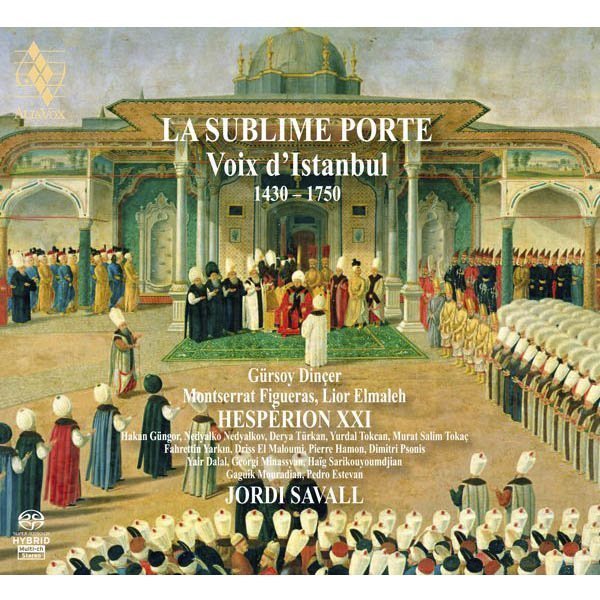LA SUBLIME PORTE
Voix d’Istanbul (1430–1750)
Hespèrion XXI, Jordi Savall, Montserrat Figueras
17,99€
Reference: AVSA9887
- Gürsoy Dinçer
- Montserrat Figueras
- Lior Elmaleh
- HESPÈRION XXI
- Jordi Savall
In 1453, some years before the fall of Granada in January 1492, a date which, after seven centuries, marked the conclusion of the Spanish Reconquista against the Arabs on the peninsula and the edict ordering the expulsion of the Jews in March of that same year, Mehmed II seized Constantinople and triggered the great division of the Mediterranean among the Christian nations and the Ottoman Empire.
Jewish travellers wear yellow turbans,while those worn by the Armenians, Greeks, Maronites,
Copts and men of all other Christian nations are bluish grey or multicoloured;
only the Turks wear white turbans…
They speak three languages […] which are common to its inhabitants.
Spanish in the case of the Jews, and Greek and Turkish, this last being the most common.
There are also some Arab and Armenian families.
Pierre Belon, Observations, 1553, pp. 400 & 457
In 1453, some years before the fall of Granada in January 1492, a date which, after seven centuries, marked the conclusion of the Spanish Reconquista against the Arabs on the peninsula and the edict ordering the expulsion of the Jews in March of that same year, Mehmed II seized Constantinople and triggered the great division of the Mediterranean among the Christian nations and the Ottoman Empire.
“Indignation prevents me from remaining silent, and sorrow prevents me from speaking my mind. We are ashamed to go on living. Italy, Germany, France and Spain are among the most prosperous States, and yet (oh, the shame of it!) we allow Constantinople to be taken by the voluptuous Turks!” These dramatic words of Cardinal Piccolomini reflected widespread public opinion in the West after the fall of the capital of Byzantium. Calls to unite in the enterprise of retaking the city were rife, and, as soon as he was elected in 1455, Pope Calixtus III (Alfons de Borja) proclaimed a crusade against the Turks. However, due to a lack of resources coupled with a lack of unified action among the Christian kingdoms, the crusade failed to materialise. The city became the capital of the Ottoman Empire and home to Islam, although it continued to be a major centre for Orthodox Christians. We should not forget, however, the circumstantial alliances and the trade agreements that were signed between nations that continued to be fierce enemies. But the most surprising turn of events of the second half of the 15th century was the letter sent in 1461 by Pope Pius II Piccolomini to Sultan Mehmed II, a doubly unusual missive in that it was sent at a time when an imminent crusade was being prepared against the sultan, and because in that letter the Pope offered to recognise the sworn enemy of Christianity as emperor on condition that he converted to Catholicism. The champion of the struggle against the Turks now proposed to legitimise the sultan’s conquests and to recognise him as the successor to Constantine, provided that he accepted baptism: “If you wish to extend your empire to Christian peoples”, he wrote, “and make your name glorious on the lips of all men, you need neither gold, nor armies, nor troops, nor ships. One small thing would suffice to make you the greatest, most powerful and illustrious of men alive today: a few drops of water for your baptism to initiate you in the Christian rite and faith in the Gospel. If you do this [….] we shall call you emperor of Greece and the East, and those lands which you have taken by force and unlawfully occupy today will become your rightful property.” To understand this offer, one needs to remember that it was regularly suggested in the West that the Turks were the heirs to the great empires of the past. Not only had they absorbed most of the kingdoms known to Antiquity, but they also had inherited the virtues of the Roman legions. After conquering, one by one, those countries which had once been within the orbit of Rome, the Ottoman army seems to have resurrected the imperial project; or rather, it seemed capable of extending its borders even further. The 15th century still cherished the imperial dream, according which looked forward to the advent of an emperor who would pave the way for the second coming of Christ. It is typical of the age, for example, that when Charles VIII entered Naples in 1495, he had himself acclaimed King of France, Emperor of Constantinople and King of Jerusalem.
+ information in the CD booklet
JORDI SAVALL
Basel, 19th September 2011
Translated by Jacqueline Minett







Share